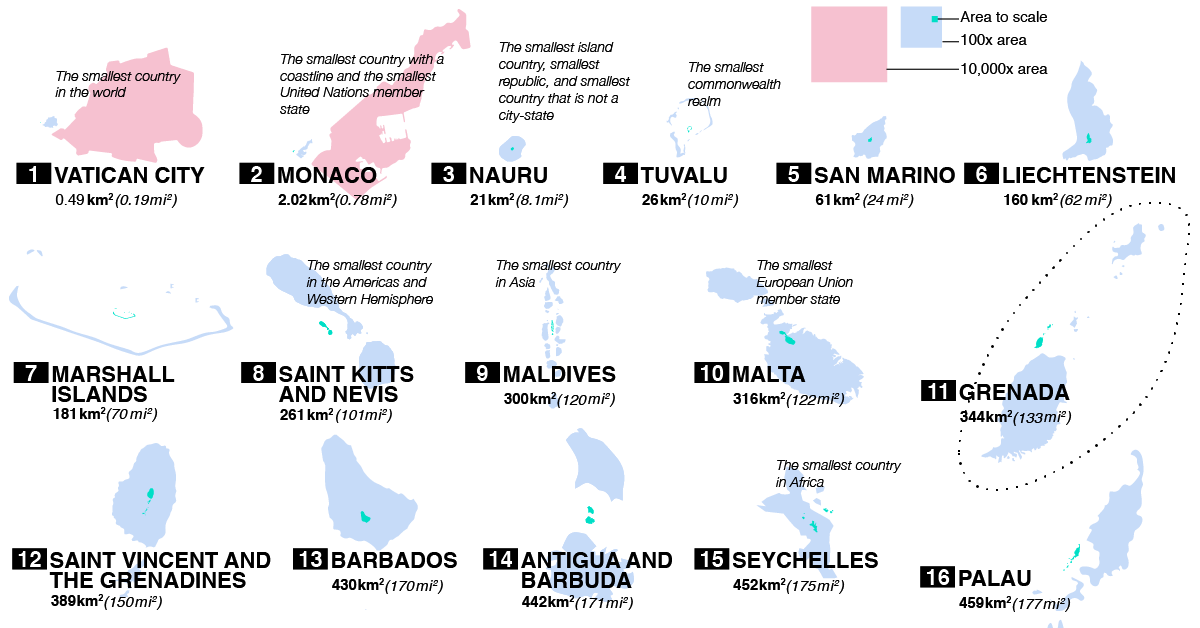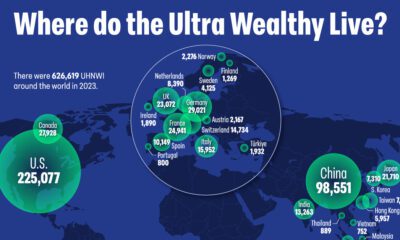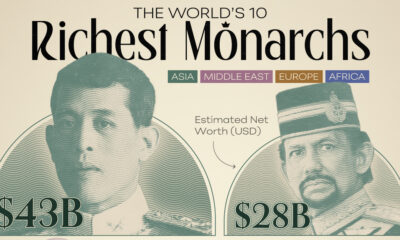Misc
Visualized: The World’s 100 Smallest Countries

The World’s 100 Smallest Countries
National borders may be mere human constructs, but they are powerful ones.
Russia, Canada, the U.S., and so on—it’s easy to focus on the countries with the largest landmasses and seemingly endless borders. Their sheer size makes them hard to ignore, and their natural resources are often vast.
But with the above graphic from TitleMax, we can focus on the power of small.
From economic might to religious influence, many of the smallest countries in the world are surprisingly powerful. Let’s take a closer look at the world’s 100 smallest countries and their spheres of influence.
| Rank | Country | Size (mi²) |
|---|---|---|
| 1 | Vatican City | 0.19 |
| 2 | Monaco | 0.78 |
| 3 | Nauru | 8.1 |
| 4 | Tuvalu | 10 |
| 5 | San Marino | 24 |
| 6 | Liechtenstein | 62 |
| 7 | Marshall Islands | 70 |
| 8 | Saint Kitts and Nevis | 101 |
| 9 | Maldives | 120 |
| 10 | Malta | 122 |
| 11 | Grenada | 133 |
| 12 | Saint Vincent and the Grenadines | 150 |
| 13 | Barbados | 170 |
| 14 | Antigua and Barbuda | 171 |
| 15 | Seychelles | 175 |
| 16 | Palau | 177 |
| 17 | Andorra | 181 |
| 18 | Saint Lucia | 238 |
| 19 | Federated States of Micronesia | 271 |
| 20 | Singapore | 280 |
| 21 | Tonga | 288 |
| 22 | Dominica | 290 |
| 23 | Bahrain | 300 |
| 24 | Kiribati | 313 |
| 25 | São Tomé and Príncipe | 372 |
| 26 | Comoros | 719 |
| 27 | Mauritius | 790 |
| 28 | Luxembourg | 998 |
| 29 | Samoa | 1,097 |
| 30 | Cape Verde | 1,557 |
| 31 | Trinidad and Tobago | 1,980 |
| 32 | Brunei | 2,226 |
| 33 | Cyprus | 3,572 |
| 34 | Lebanon | 4,036 |
| 35 | Jamaica | 4,244 |
| 36 | The Gambia | 4,361 |
| 37 | Qatar | 4,473 |
| 38 | Vanuatu | 4,706 |
| 39 | Montenegro | 5,333 |
| 40 | The Bahamas | 5,383 |
| 41 | imor-Leste | 5,760 |
| 42 | Eswatini | 6,704 |
| 43 | Kuwait | 6,880 |
| 44 | Fiji | 7,055 |
| 45 | Slovenia | 7,827 |
| 46 | Israel | 8,020 |
| 47 | El Salvador | 8,124 |
| 48 | Belize | 8,867 |
| 49 | Djibouti | 9,000 |
| 50 | North Macedonia | 9,928 |
| 51 | Rwanda | 10,169 |
| 52 | Haiti | 10,710 |
| 53 | Burundi | 10,747 |
| 54 | Equatorial Guinea | 10,831 |
| 55 | Albania | 11,100 |
| 56 | Solomon Islands | 11,157 |
| 57 | Armenia | 11,484 |
| 58 | Lesotho | 11,720 |
| 59 | Belgium | 11,787 |
| 60 | Moldova | 13,068 |
| 61 | Guinea-Bissau | 13,948 |
| 62 | Bhutan | 14,824 |
| 63 | Switzerland | 15,940 |
| 64 | Netherlands | 16,160 |
| 65 | Denmark | 16,639 |
| 66 | Estonia | 17,462 |
| 67 | Dominican Republic | 18,792 |
| 68 | Slovakia | 18,933 |
| 69 | Costa Rica | 19,700 |
| 70 | Bosnia and Herzegovina | 19,772 |
| 71 | Croatia | 21,851 |
| 72 | Togo | 21,925 |
| 73 | Latvia | 24,926 |
| 74 | Lithuania | 25,200 |
| 75 | Sri Lanka | 25,330 |
| 76 | Georgia | 26,900 |
| 77 | Ireland | 27,133 |
| 78 | Sierra Leone | 27,700 |
| 79 | Panama | 29,119 |
| 80 | Czech Republic | 30,450 |
| 81 | United Arab Emirates | 32,300 |
| 82 | Austria | 32,383 |
| 83 | Azerbaijan | 33,400 |
| 84 | Serbia | 34,116 |
| 85 | Jordan | 34,495 |
| 86 | Portugal | 35,560 |
| 87 | Hungary | 35,918 |
| 88 | South Korea | 38,690 |
| 89 | Iceland | 40,000 |
| 90 | Guatemala | 42,042 |
| 91 | Cuba | 42,426 |
| 92 | Bulgaria | 42,858 |
| 93 | Liberia | 43,000 |
| 94 | Honduras | 43,433 |
| 95 | Benin | 44,310 |
| 96 | Eritrea | 45,400 |
| 97 | Malawi | 45,747 |
| 98 | North Korea | 46,540 |
| 99 | Nicaragua | 50,337 |
| 100 | Greece | 50,949 |
Although several of the national borders shown above may be contested, the graphic gives us a clear overview of the globe’s smallest nations.
The Power of Small
Small size doesn’t mean less power. In many cases, it’s the contrary.
The Vatican—the smallest country on Earth at 0.19 square miles—is renowned for its leader and main inhabitant, the Pope. As leader of the Catholic Church, the pontiff and his papal staff make up a sizable part of the country’s tiny population of 825. Most of the Church’s 219 Cardinals, its leading dignitaries, live in their respective dioceses.
With more than 1.2 billion Roman Catholics in the world, the Vatican’s sphere of influence is of course far larger than its small physical size. Although the walls of the Vatican are situated inside the city of Rome, Italy, its centuries-old influence spans continents.
Nearly 40% of Roman Catholics live in the Americas, while the fastest-growing Catholic population can be found in Africa—home to more than 17% of the world’s Catholics.
Purchasing Power
Where the Vatican’s power lies in religion, plenty of spending power is held by the tiny country of Monaco, the second smallest country on Earth.
Situated along the French Riviera, Monaco is surrounded entirely by France—but it also sits fewer than 10 miles from the Italian border.
At 0.78 square miles, Monaco could be compared to the size of a large farm in the U.S. Midwest. Despite its small size, Monaco has a GDP of nearly US$7.2 billion, and boasts over 12,000 millionaires living within one square mile.
Along with Luxembourg and Liechtenstein—both of which are included in the smallest countries list—Monaco is one of the only countries globally with a GDP per capita higher than $100,000.
Switzerland and the Netherlands, both found in this graphic at ranks 63 and 64, also hold large shares of the global economy given their size. These two nations rank 20th and 17th in the world in economic output, respectively.
Similarly, Singapore is the 20th smallest country on the planet, but it ranks in the top 10 in terms of GDP per capita ($65,233) and sits in 34th place globally in terms of nominal GDP.
Perspective is Everything
To give us a better idea of just how small the tiniest countries are, let’s take a look at some simple size comparisons:
- Monaco could fit inside New York City’s Central Park, with room to spare
- Brunei is roughly the same size as Delaware
- Nicaragua, the largest country in Central America, is similar in size to the state of Mississippi
- Nauru is the smallest island nation, and smaller than Rhode Island
- North Korea is roughly the size of Pennsylvania
“Small,” of course, is a qualitative factor. It depends on your vantage point.
As of September 2020, there are 195 countries on Earth. Although this graphic shows the smallest countries in the world, it is worth noting that a list of the world’s 100 largest countries would also include some of the same countries on this list, including North Korea, Nicaragua, and Greece.
Is It A Small World Afterall?
Viewed from space, there are no borders on our tiny blue dot. But from ground level, we know how much power national borders hold.
Although globalization may make our world feel smaller, our nations significantly impact our lives, societally and economically.
And, as this chart shows, power comes in all sizes.
Misc
How Hard Is It to Get Into an Ivy League School?
We detail the admission rates and average annual cost for Ivy League schools, as well as the median SAT scores required to be accepted.

How Hard Is It to Get Into an Ivy League School?
This was originally posted on our Voronoi app. Download the app for free on iOS or Android and discover incredible data-driven charts from a variety of trusted sources.
Ivy League institutions are renowned worldwide for their academic excellence and long-standing traditions. But how hard is it to get into one of the top universities in the U.S.?
In this graphic, we detail the admission rates and average annual cost for Ivy League schools, as well as the median SAT scores required to be accepted. The data comes from the National Center for Education Statistics and was compiled by 24/7 Wall St.
Note that “average annual cost” represents the net price a student pays after subtracting the average value of grants and/or scholarships received.
Harvard is the Most Selective
The SAT is a standardized test commonly used for college admissions in the United States. It’s taken by high school juniors and seniors to assess their readiness for college-level academic work.
When comparing SAT scores, Harvard and Dartmouth are among the most challenging universities to gain admission to. The median SAT scores for their students are 760 for reading and writing and 790 for math. Still, Harvard has half the admission rate (3.2%) compared to Dartmouth (6.4%).
| School | Admission rate (%) | SAT Score: Reading & Writing | SAT Score: Math | Avg Annual Cost* |
|---|---|---|---|---|
| Harvard University | 3.2 | 760 | 790 | $13,259 |
| Columbia University | 3.9 | 750 | 780 | $12,836 |
| Yale University | 4.6 | 760 | 780 | $16,341 |
| Brown University | 5.1 | 760 | 780 | $26,308 |
| Princeton University | 5.7 | 760 | 780 | $11,080 |
| Dartmouth College | 6.4 | 760 | 790 | $33,023 |
| University of Pennsylvania | 6.5 | 750 | 790 | $14,851 |
| Cornell University | 7.5 | 750 | 780 | $29,011 |
*Costs after receiving federal financial aid.
Additionally, Dartmouth has the highest average annual cost at $33,000. Princeton has the lowest at $11,100.
While student debt has surged in the United States in recent years, hitting $1.73 trillion in 2023, the worth of obtaining a degree from any of the schools listed surpasses mere academics. This is evidenced by the substantial incomes earned by former students.
Harvard grads, for example, have the highest average starting salary in the country, at $91,700.
-

 Real Estate2 weeks ago
Real Estate2 weeks agoVisualizing America’s Shortage of Affordable Homes
-

 Technology1 week ago
Technology1 week agoRanked: Semiconductor Companies by Industry Revenue Share
-

 Money1 week ago
Money1 week agoWhich States Have the Highest Minimum Wage in America?
-

 Real Estate1 week ago
Real Estate1 week agoRanked: The Most Valuable Housing Markets in America
-

 Business2 weeks ago
Business2 weeks agoCharted: Big Four Market Share by S&P 500 Audits
-

 AI2 weeks ago
AI2 weeks agoThe Stock Performance of U.S. Chipmakers So Far in 2024
-

 Misc2 weeks ago
Misc2 weeks agoAlmost Every EV Stock is Down After Q1 2024
-

 Money2 weeks ago
Money2 weeks agoWhere Does One U.S. Tax Dollar Go?















